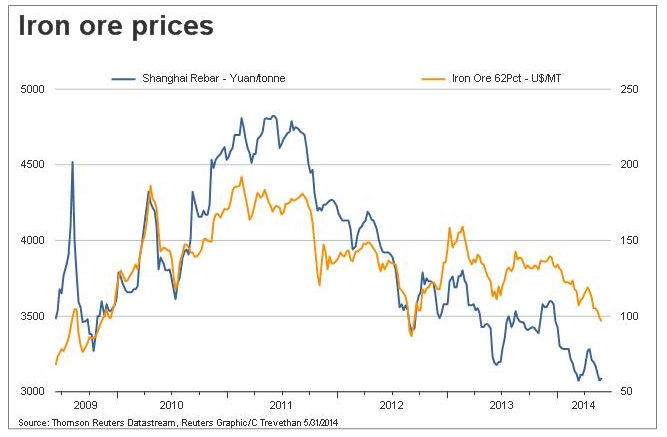It was a bad week for the mining sector with heavyweights BHP Billiton dropping over 4% in the last 7 days to £18.68, Anglo American dropped 7.3% for the week and fell 5.7% on Friday to close at £14.57 and Rio Tinto fell 6.15% on the week to £30.57 after a 4% fall on Friday.
Iron ore prices are continuing their downward spiral, moving below the critical $100 a tonne level in the last week or so to hit $97.5, particularly bad news for companies with significant exposure like BHP Billiton. The price of iron ore has been hit by a sharply falling steel price in China and rising production from cheap Australian mines meaning it is now trading at a 20 month low. Sentiment towards miners also wasn’t helped by a profits warning from Fenner Plc , a maker of conveyor belts for the mining industry, warned it might miss market expectations for full-year profit as troubled U.S. coal miners continue to defer spending on maintenance.

Last week Glencore’s Ivan Glasenberg was critical of the large global miners saying that they were spending billions of dollars on expanding existing mines, mainly in iron ore and swamping the market with new supply with an unhealthy “obsession” with organic volume growth.
There were reports from China that the government had asked local/regional officials to increase spending due to sluggish growth in the economy, further increasing worries about demand for metals and ores from the world’s second largest economy. Since commodities are priced in dollars, a strengthening of the US dollar didn’t help matters after the European Central Bank indicated it would cut rates to try and boost growth in the face of Japanese style deflation. Traders sold the euro and piled into the US dollar meaning that gold and other commodities dropped in value.
Of course things are much better for platinum producers, with the ongoing strikes in South Africa taking a heavy toll. South Africa’s economy has contracted for the first time since the financial crisis of 2008-09 with a 0.6% quarter on quarter drop after mining production fell the most in nearly 50 years as a result of the strikes. The South African operations of the world’s three biggest platinum producers – Anglo American Platinum, Impala, and Lonmin have been impacted since late January and as a result South Africa’s Mining and quarrying output shrank by nearly 25 per cent in the year ending March 2014, the biggest decrease since 1967.

All this makes JP Morgan’s upgrade of the miners in mid-May look a little premature with their prediction that cost cutting would offset any pricing pressures, “We believe the risk-reward for miners appears better due to strong cost-cutting drive, a huge past repricing in earnings and in performance, especially if near-term data flow picks up.”
The worries of the mining sector mean that unlike the US market which is hitting all time highs, the FTSE 100 which has a large commodity based weighting is still short of its all time high of 6930 achieved back in December 1999 before the dot com crash. There is significant volatility in the mining shares right now and this isn’t likely to finish anytime soon.
Contrarian Investor UK
IMPORTANT: The posts I make are in no way meant as investment suggestions or recommendations to any visitors to the site. They are simply my views, personal reflections and analysis on the markets. Anyone who wishes to spread bet or buy stocks should rely on their own due diligence and common sense before placing any spread trade.
by contrarianuk
Heavy sell off in miners triggered by further worries about China and stronger US dollar
May 31, 2014 at 3:38 pm in Market Commentary by contrarianuk
It was a bad week for the mining sector with heavyweights BHP Billiton dropping over 4% in the last 7 days to £18.68, Anglo American dropped 7.3% for the week and fell 5.7% on Friday to close at £14.57 and Rio Tinto fell 6.15% on the week to £30.57 after a 4% fall on Friday.
Iron ore prices are continuing their downward spiral, moving below the critical $100 a tonne level in the last week or so to hit $97.5, particularly bad news for companies with significant exposure like BHP Billiton. The price of iron ore has been hit by a sharply falling steel price in China and rising production from cheap Australian mines meaning it is now trading at a 20 month low. Sentiment towards miners also wasn’t helped by a profits warning from Fenner Plc , a maker of conveyor belts for the mining industry, warned it might miss market expectations for full-year profit as troubled U.S. coal miners continue to defer spending on maintenance.
Last week Glencore’s Ivan Glasenberg was critical of the large global miners saying that they were spending billions of dollars on expanding existing mines, mainly in iron ore and swamping the market with new supply with an unhealthy “obsession” with organic volume growth.
There were reports from China that the government had asked local/regional officials to increase spending due to sluggish growth in the economy, further increasing worries about demand for metals and ores from the world’s second largest economy. Since commodities are priced in dollars, a strengthening of the US dollar didn’t help matters after the European Central Bank indicated it would cut rates to try and boost growth in the face of Japanese style deflation. Traders sold the euro and piled into the US dollar meaning that gold and other commodities dropped in value.
Of course things are much better for platinum producers, with the ongoing strikes in South Africa taking a heavy toll. South Africa’s economy has contracted for the first time since the financial crisis of 2008-09 with a 0.6% quarter on quarter drop after mining production fell the most in nearly 50 years as a result of the strikes. The South African operations of the world’s three biggest platinum producers – Anglo American Platinum, Impala, and Lonmin have been impacted since late January and as a result South Africa’s Mining and quarrying output shrank by nearly 25 per cent in the year ending March 2014, the biggest decrease since 1967.
All this makes JP Morgan’s upgrade of the miners in mid-May look a little premature with their prediction that cost cutting would offset any pricing pressures, “We believe the risk-reward for miners appears better due to strong cost-cutting drive, a huge past repricing in earnings and in performance, especially if near-term data flow picks up.”
The worries of the mining sector mean that unlike the US market which is hitting all time highs, the FTSE 100 which has a large commodity based weighting is still short of its all time high of 6930 achieved back in December 1999 before the dot com crash. There is significant volatility in the mining shares right now and this isn’t likely to finish anytime soon.
Contrarian Investor UK
IMPORTANT: The posts I make are in no way meant as investment suggestions or recommendations to any visitors to the site. They are simply my views, personal reflections and analysis on the markets. Anyone who wishes to spread bet or buy stocks should rely on their own due diligence and common sense before placing any spread trade.